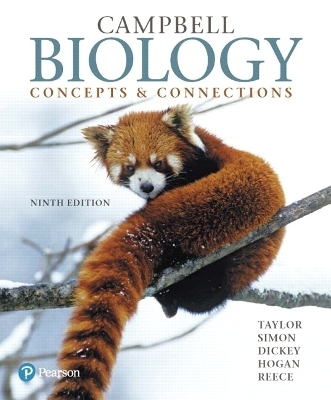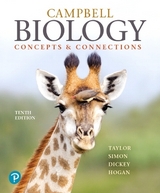
Campbell Biology
Pearson (Verlag)
978-0-13-429601-2 (ISBN)
- Titel erscheint in neuer Auflage
- Artikel merken
A conceptual framework for understanding the world of biology
Campbell Biology: Concepts & Connections
continues to introduce pedagogical innovations, which motivate students not only to learn, but also engage with biology. This bestselling textbook is designed to help students stay focused with its hallmark modular organization around central concepts and engages students in connections between concepts and the world outside of the classroom with Scientific Thinking, Evolution Connection and Connection essays in every chapter. The 9th Edition offers students a framework organized around fundamental biological themes and encourages them to analyze visual representations of data with new Visualizing the Data figures. A reorganized Chapter One emphasizes the process of science and scientific reasoning, and robust instructor resources and multimedia allow students to engage with biological concepts in a memorable way. Unparalleled resources let instructors develop active and high interest lectures with ease.
The book and Mastering™ Biology work together to help students practice making these connections throughout their text.
Also available with Mastering Biology or as an easy-to-use, standalone Pearson eText
Mastering Biology is an online homework, tutorial, and assessment product designed to improve results by helping students quickly master concepts. Students benefit from self-paced activities that feature personalized wrong-answer feedback to emulate the office-hour experience and help keep students on track. With a wide range of interactive, engaging, and assignable activities, many of them created by the Campbell Biology: Concepts and Connections authors, students are encouraged to actively learn and retain tough course concepts. New Mastering Biology activities for this edition include “Key Topic Overview” videos that help students efficiently review key topics outside of class, “Evaluating Science in the Media” activities that help students to build science literacy skills, and more “Visualizing the Concept” animated videos help students further visualize and understand complex biological processes.
Pearson eText allows educators to easily share their own notes with students so they see the connection between their reading and what they learn in class—motivating them to keep reading, and keep learning. Portable access lets students study on the go, even offline. And, reading analytics offer insight into how students use the eText, helping educators tailor their instruction.
Note: You are purchasing a standalone product; Mastering Biology and Pearson eText do not come packaged with this content. Students, if interested in purchasing this title with Mastering Biology or Pearson eText, ask your instructor for the correct package ISBN and Course ID. Instructors, contact your Pearson representative for more information.
If you would like to purchase both the physical text and Mastering Biology, search for:
0134240685 / 9780134240688 Campbell Biology: Concepts & Connections Plus Mastering Biology with eText -- Access Card Package
Package consists of:
0134536266 / 9780134536262 Mastering Biology with Pearson eText -- ValuePack Access Card -- for Campbell Biology: Concepts & Connections
013429601X / 9780134296012 Campbell Biology: Concepts & Connections
If you would like to purchase the standalone Pearson eText, search for:
0135213827 / 9780135213827 Pearson eText Campbell Biology: Concepts & Connections -- Access Card
OR
0135213843 / 9780135213841 Pearson eText Campbell Biology: Concepts & Connections -- Instant Access
Martha R. Taylor has been teaching biology for more than 35 years. She earned her B.A. in biology from Gettysburg College and her M.S. and Ph.D. in science education from Cornell University. At Cornell, Dr. Taylor has served as assistant director of the Office of Instructional Support and has taught introductory biology for both majors and nonmajors. Most recently, she was a lecturer in the Learning Strategies Center, teaching supplemental biology courses. Her experience working with students in classrooms, in laboratories, and with tutorials has increased her commitment to helping students create their own knowledge of and appreciation for biology. She was the author of the Student Study Guide for ten editions of Campbell Biology. Eric J. Simon is a professor in the Department of Biology and Health Science at New England College in Henniker, New Hampshire. He teaches introductory biology to science majors and nonscience majors, as well as upper-level courses in tropical marine biology and careers in science. Dr. Simon received a B.A. in biology and computer science and an M.A. in biology from Wesleyan University, and a Ph.D. in biochemistry from Harvard University. His research focuses on innovative ways to use technology to improve teaching and learning in the science classroom. Dr. Simon also leads numerous international student field research trips and is a Scientific Advisor to the Elephant Conservation Center in Sayaboury, Laos. Dr. Simon is the lead author of the introductory nonmajors biology textbooks Campbell Essential Biology, Sixth Edition, and Campbell Essential Biology with Physiology, Fifth Edition, and the author of the introductory biology textbook Biology: The Core, Second Edition. Jean L. Dickey is Professor Emerita of Biological Sciences at Clemson University (Clemson, South Carolina). After receiving her B.S. in biology from Kent State University, she went on to earn a Ph.D. in ecology and evolution from Purdue University. In 1984, Dr. Dickey joined the faculty at Clemson, where she devoted her career to teaching biology to nonscience majors in a variety of courses. In addition to creating content-based instructional materials, she developed many activities to engage lecture and laboratory students in discussion, critical thinking, and writing, and implemented an investigative laboratory curriculum in general biology. Dr. Dickey is author of Laboratory Investigations for Biology, Second Edition, and coauthor of Campbell Essential Biology, Sixth Edition, and Campbell Essential Biology with Physiology, Fifth Edition. Kelly Hogan is a faculty member in the Department of Biology at the University of North Carolina at Chapel Hill, teaching introductory biology and genetics. Dr. Hogan teaches hundreds of students at a time, using active-learning methods that incorporate educational technologies both inside and outside of the classroom. She received her B.S. in biology at the College of New Jersey and her Ph.D. in pathology at the University of North Carolina, Chapel Hill. Her research interests focus on how large classes can be more inclusive through evidence-based teaching methods and technology. As the Director of Instructional Innovation at UNC, she encourages experienced faculty to take advantage of new professional development opportunities and inspires the next generation of innovative faculty. Dr. Hogan is the author of Stem Cells and Cloning, Second Edition, and co-author on Campbell Essential Biology with Physiology, Fifth Edition. Jane B. Reece has worked in biology publishing since 1978, when she joined the editorial staff of Benjamin Cummings. Her education includes an A.B. in biology from Harvard University, an M.S. in microbiology from Rutgers University, and a Ph.D. in bacteriology from the University of California, Berkeley. At UC Berkeley, and later as a postdoctoral fellow in genetics at Stanford University, her research focused on genetic recombination in bacteria. Dr. Reece taught biology at Middlesex County College (New Jersey) and Queensborough Community College (New York). During her 12 years as an editor at Benjamin Cummings, she played a major role in a number of successful textbooks. She is coauthor of Campbell Biology, Eleventh Edition, Campbell Biology in Focus, Second Edition, Campbell Essential Biology, Sixth Edition, and Campbell Essential Biology with Physiology, Fifth Edition. Neil A. Campbell (1946—2004) combined the inquiring nature of a research scientist with the soul of a caring teacher. Over his 30 years of teaching introductory biology to both science majors and nonscience majors, many thousands of students had the opportunity to learn from him and be stimulated by his enthusiasm for the study of life. While he is greatly missed by his many friends in the biology community, his coauthors remain inspired by his visionary dedication to education and are committed to searching for ever better ways to engage students in the wonders of biology
1. Biology: Exploring Life
I. THE LIFE OF THE CELL
2. The Chemical Basis of Life
3. The Molecules of Cells
4. A Tour of the Cell
5. The Working Cell
6. How Cells Harvest Chemical Energy
7. Photosynthesis: Using Light to Make Food
II. CELLULAR REPRODUCTION AND GENETICS
8. The Cellular Basis of Reproduction and Inheritance
9. Patterns of Inheritance
10. Molecular Biology of the Gene
11. How Genes Are Controlled
12. DNA Technology and Genomics
III. CONCEPTS OF EVOLUTION
13. How Populations Evolve
14. The Origin of Species
15. Tracing Evolutionary History
IV. THE EVOLUTION OF BIOLOGICAL DIVERSITY
16. Microbial Life: Prokaryotes and Protists
17. The Evolution of Plant and Fungal Diversity
18. The Evolution of Invertebrate Diversity
19. The Evolution of Vertebrate Diversity
V. ANIMALS: FORM AND FUNCTION
20. Unifying Concepts of Animal Structure and Function
21. Nutrition and Digestion
22. Gas Exchange
23. Circulation
24. The Immune System
25. Control of Body Temperature and Water Balance
26. Hormones and the Endocrine System
27. Reproduction and Embryonic Development
28. Nervous Systems
29. The Senses
30. How Animals Move
VI. PLANTS: FORM AND FUNCTION
31. Plant Structure, Growth, and Reproduction
32. Plant Nutrition and Transport
33. Control Systems in Plants
VII. ECOLOGY
34. The Biosphere: An Introduction to Earth's Diverse Environments
35. Behavioral Adaptations to the Environment
36. Population Ecology
37. Communities and Ecosystems
38. Conservation Biology
Appendix 1 Metric Conversion Table
Appendix 2 The Periodic Table
Appendix 3 The Amino Acids of Proteins
Appendix 4 Chapter Review Answers
Appendix 5 Credits
Glossary
Index
| Erscheinungsdatum | 28.02.2017 |
|---|---|
| Sprache | englisch |
| Maße | 100 x 100 mm |
| Gewicht | 100 g |
| Themenwelt | Naturwissenschaften ► Biologie |
| ISBN-10 | 0-13-429601-X / 013429601X |
| ISBN-13 | 978-0-13-429601-2 / 9780134296012 |
| Zustand | Neuware |
| Informationen gemäß Produktsicherheitsverordnung (GPSR) | |
| Haben Sie eine Frage zum Produkt? |
aus dem Bereich



